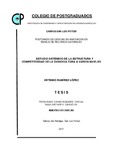| dc.contributor.advisor | Ramírez Valverde, Benito | es_MX |
| dc.contributor.advisor | Morales Flores, Francisco Javier | es_MX |
| dc.contributor.author | Ramírez López, Artemio | es_MX |
| dc.creator | RAMIREZ LOPEZ, ARTEMIO; 646732 | |
| dc.date.accessioned | 2019-01-16T23:02:22Z | |
| dc.date.available | 2019-01-16T23:02:22Z | |
| dc.date.issued | 2017-06 | |
| dc.identifier.citation | Ramírez López, A. (2017). Estudio sistémico de la estructura y competitividad de la ovinocultura a varios niveles. Salinas de Hidalgo, S. L. P. : La autora, Tesis (Maestría en Ciencias, especialista en Innovación en el Manejo de Recursos Naturales), Colegio de Postgraduados, Campus San Luis Potosí, 2017 | es_MX |
| dc.identifier.uri | http://hdl.handle.net/10521/3118 | |
| dc.description.abstract | El presente estudio consistió en la caracterización de la estructura y la competitividad de la ovinocultura bajo un enfoque sistémico a nivel mundial, nacional y regional. Los resultados sugieren que la estructura del mercado mundial de exportación de carne de ovino está altamente concentrada (duopolio). En tanto el análisis de la competitividad señaló a Nueva Zelanda como el único país dominante en el mercado. Por su parte, la ovinocultura en México está desconcentrada y carece de uniformidad, siendo necesarias políticas públicas diferenciadas para su desarrollo. Mediante la tipificación de los municipios productores de ovino en México se obtuvieron cuatro grupos: empresarial, transicional, complemento al empleo rural y autoconsumo. Los resultados sobre confianza muestran que los productores de la región Altiplano Oeste Potosino (AOP) confían más en otros productores que en clientes y proveedores. El vínculo con mayor confianza en ambas estrategias (agrícolas y pecuarias) fue el familiar. Finalmente, la relación entre las características demandadas por los compradores permitió apreciar la manera en que se organiza la cadena productiva de ovinos en la AOP. Es posible que los pesos bajos en los animales comercializados se deban a un mal manejo sanitario y a limitadas condiciones de pastoreo. La preferencia en la compra de animales jóvenes puede estar condicionando la capacidad de los productores de la región para obtener una mejor ganancia por la venta de su ganado, limitando su integración a la cadena productiva y la transición de ésta hacia una cadena de valor. | es_MX |
| dc.description.abstract | ABSTRACT: The present study consisted of the characterization of the structure and the competitiveness of the sheep under a systemic approach at world, national and regional level. The results suggest that the structure of the global sheepmeat export market is highly concentrated (duopoly). While the competitiveness analysis pointed to New Zealand as the only dominant country in the market. On the other hand, the sheep production in Mexico is deconcentrated and lacks uniformity, being necessary public policies differentiated for its development. The classification of sheep-producing municipalities in Mexico yielded four groups: business, transitional, complement to rural employment and self-consumption. Trust results show that producers in the Altiplano Oeste Potosino (AOP) region rely more on producers than customers and suppliers. The link with greater trust in both strategies (agricultural and livestock) was the familiar one. Finally, the relation between the characteristics demanded by the buyers allowed to appreciate the way in which the productive chain of sheep in the AOP is organized. It is possible that low weights in marketed animals are due to poor sanitary management and limited grazing conditions. Preference in the purchase of young animals may be conditioning the capacity of producers in the region to obtain a better profit from the sale of their livestock, limiting their integration into the productive chain and the transition from the latter to a value chain. | es_MX |
| dc.description.sponsorship | Conacyt | es_MX |
| dc.format | pdf | es_MX |
| dc.format.extent | 2,772 Kb | es_MX |
| dc.language.iso | spa | es_MX |
| dc.publisher | El autor | es_MX |
| dc.rights.uri | http://creativecommons.org/licenses/by-nc-nd/4.0 | es_MX |
| dc.subject | Research Subject Categories::FORESTRY, AGRICULTURAL SCIENCES and LANDSCAPE PLANNING::Animal production::Animal nutrition and management | es_MX |
| dc.subject.classification | CIENCIAS AGROPECUARIAS Y BIOTECNOLOGÍA::CIENCIAS AGRARIAS::PRODUCCIÓN ANIMAL::OVINOS | es_MX |
| dc.subject.other | Maestría | es_MX |
| dc.subject.other | IMRN | es_MX |
| dc.subject.other | Ovinos | es_MX |
| dc.subject.other | Altiplano Oeste Potosino | es_MX |
| dc.subject.other | Competitividad | es_MX |
| dc.subject.other | Sistemas agropascícolas | es_MX |
| dc.subject.other | Agropastoral systems | en |
| dc.subject.other | Sheep | en |
| dc.subject.other | Small ruminants | en |
| dc.subject.other | Pequeños rumiantes | es_MX |
| dc.subject.other | Cadena de suministro de alimentos | es_MX |
| dc.subject.other | Food supply chain | en |
| dc.subject.other | Investigación de mercados | es_MX |
| dc.subject.other | Market research | en |
| dc.title | Estudio sistémico de la estructura y competitividad de la ovinocultura a varios niveles. | es_MX |
| dc.title.alternative | Systemic analysis of the structure and competitiveness of the sheep production at different levels. | es_MX |
| dc.type | Tesis | es_MX |
| Tesis.date.submitted | 2017-06 | |
| Tesis.date.accesioned | 2019-01 | |
| Tesis.date.available | 2019-01 | |
| Tesis.rights | Acceso abierto | es_MX |
| dc.type.conacyt | masterThesis | es_MX |
| dc.identificator | 6||31||3104||310407 | es_MX |
| dc.contributor.director | FIGUEROA SANDOVAL, BENJAMIN; 1911 | |
| dc.contributor.director | FIGUEROA RODRIGUEZ, KATIA ANGELICA; 37293 | |
| dc.audience | generalPublic | es_MX |


